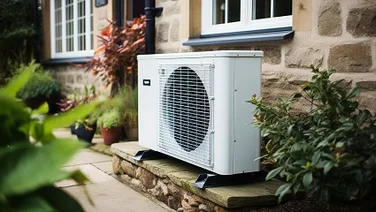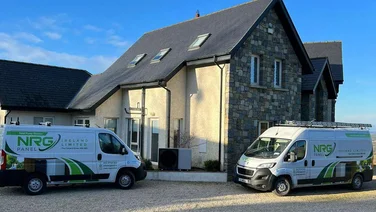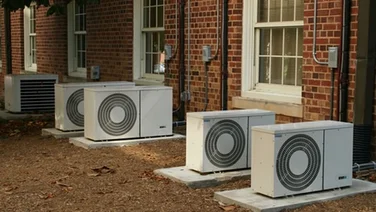✔ A heat pump cover will typically cost you £400-£1,000
✔ A cover can prevent your unit from being damaged by strong winds
✔ Fill in the form at the top of the page for quotes from trusted installers
Despite the high cost of heat pumps, they’re about to explode in popularity in the UK, thanks to the government’s Boiler Upgrade Scheme.
Not only can these innovations of green tech save you money on your bills and lower your carbon footprint, but they’re also pretty sturdy machines – lasting up to 20 years.
If you’ve already got yourself an air source heat pump, you’ll know that it can take quite a beating from various weather conditions. Wind can batter it, twigs can pummel it, and snow can freeze it over – and it’ll still keep providing you energy. However, after a long period of time, this exposure can lower its efficiency.
Want to keep your air source heat pump in tip-top condition, safe from harsh weather conditions? It might be worth looking into heat pump covers (also known as guards or enclosures).
Luckily, we’ve got everything you need to know about these handy devices below!
Want to skip the reading? Find the best heat pump for your home by using our custom-built comparison tool.
Simply fill in this free form, and our professional installers will be in touch with the best quotes around.
What type of central heating do you currently use?
Get started
What’s on this page?
What is an air source heat pump cover?
An air source heat pump cover does what it says on the tin – it literally keeps your heat pump covered, away from inclement weather.
Since air source heat pumps have an external unit located outside, they can get damaged by strong winds (which can also throw debris around) or snowy weather. If your home is located somewhere where this is particularly common, a heat pump cover could prevent you from having to deal with regular repairs.
Typically, a heat pump guard will box itself around the outside unit, protecting it from the elements whilst also maintaining good ventilation and airflow.
If you’re tempted to buy a heat pump cover, make sure to do your research. Some enclosures are built with appearance in mind, without considering how much a certain design could reduce the overall efficiency.

Does your heat pump need a cover?
Not all heat pumps need a cover – in fact, there’s a very hot debate about whether any heat pumps need covering. A heat pump is a very strong and robust piece of machinery, and blocking part of the outside unit can reduce its effectiveness.
However, if your home experiences pretty rough weather conditions regularly, it could be worth trying a heat pump guard.
By sheltering your heat pump, you could prevent the external unit from getting damaged by strong winds, keep the mechanisms from getting blocked by stray foliage, and even make it less likely to freeze over during winter.
Find out more about heat pump problems by going to our page.
Another key reason why some people opt for a heat pump enclosure is to reduce noise levels. Don’t get us wrong, heat pumps aren’t outrageously loud machines, but you might notice a humming sound if you live in a quiet neighbourhood.
And, if you have a number of properties close to your home – if your heat pump is located on a balcony, for example – then your neighbours might hear it.
However, the Energy Saving Trust suggests that, unless the heat pump is working very hard (like when the weather is cold or when the system is producing hot water), you can expect the noise to be a similar volume to a fridge’s hum.
If this sounds like an issue you might have to deal with, it might be worth looking into heat pump covers. By having a box around the unit, you’ll be adding an additional barrier for the sound to travel through, and this will likely reduce the noise pollution.
Owners of listed buildings, or homes in conservation areas, might also find air source heat pump covers useful.
If you live in a home where you want to (or have to) preserve its traditional look, a heat pump cover can help keep the aesthetic intact. Most enclosures are made of wood, and can either have a traditional finish or be painted a specific colour to match with the house.
What type of central heating do you currently use?
Get startedWant to get a better idea of what it’s like to own an air source heat pump? Check out our case study with Louise, from South London.
Louise had a 12-kilowatt air source heat pump installed to reduce her reliance on fossil fuels, and received £5,000 off the upfront cost through the Boiler Upgrade Scheme. Now, Louise can enjoy a warm, even temperature throughout the house, without fluctuations.
Take a look at the full interview with Louise to learn more.
How much does a heat pump cover cost?
Costs for heat pump covers vary a lot, depending on the size and material that you choose.
On the lower end of the spectrum, you can expect to pay a few hundred pounds for a mesh cage to go over your heat pump, and wooden guards will typically cost a little bit more.
For a metal mesh guard, you can expect to pay between £400-£800 – although, this will depend on the size you get.
Wooden covers, on the other hand, can be slightly more expensive, ranging from around £500-£900. Again, this depends on the size that you get, and whether you’d like to get any sort of finish on the wood.
Some companies offer solid metal covers, which look very aesthetically pleasing, but need specialised airflow management that helps ventilation to make sure the heat pump remains efficient. These systems can cost over £1,000, but it depends on which company you go with.

Different types of heat pump cover
Covers come in all shapes and sizes.
In terms of material, you typically have two options: wood or metal.
Wooden covers are usually the better option if you’re more concerned about the aesthetics – but make sure there’s still a lot of room for your heat pump to work efficiently.
If you’re going for a metal guard, you can either have a mesh design, which protects the heat pump from incoming debris, or you can have a solid metal enclosure, which will look nicer but need to have unique airflow management to help ventilation.
On top of style, you’ll usually have the option to choose from a range of different sizes, to make sure all heat pumps can fit inside a cover with lots of space around the outsides. There’s no official recommended amount of space to have around a heat pump – the Energy Saving Trust simply states that “it must have some space around it to allow a good flow of air.”
Next steps
Not every home will need a heat pump guard, but it could come in handy for some properties. Whether you want to improve the appearance of your heat pump unit, or prevent it from getting damaged, there are plenty of options out there for you.
Want to learn more about heat pumps, and how to look after them? Check out our helpful guide on air source heat pump maintenance.
If you’ve decided to get a heat pump, the next step is finding the right deal – which is where we come in.
Simply fill in this free form and let us take the reins. We’ll pass on your details to our professional heat pump installers, who will then get in touch with their best prices.






